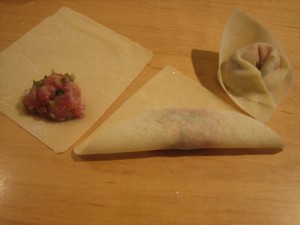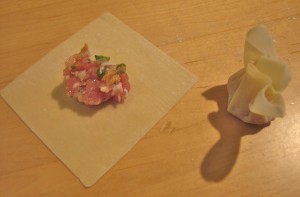Ready to make wontons? Start with a great filling. I have a delicious option in The Hakka Cookbook, page 148. Ground pork is flecked with dried orange peel (use fresh, if you don’t have dried). Tianjin preserved vegetables (use soy sauce as a substitute) contribute a savory saltiness. And chunks of water chestnut pebble the filling with crunchy texture. Use the mixture as a filling for wonton or pat it into even layer and steam to make a juicy pork hash, Chinese comfort food.
For wonton, wrap the filling in a square pasta-like wonton skin, available in supermarkets and Asian grocery stores. There are many ways to fill wonton. My three-year grand daughter proved that to be true as she created her own technique for filling them. When boiled, it doesn’t make much difference. When I wrote the recipe to make wontons, I tried to find the technique that would be the most easily understood without photos. Unfortunately, the publisher had no budget for photos but you can see them here.

Place filling in center of wonton skin. Fold skin over filling to make a triangle. Pull ends down and seal tips with a little beaten egg.
For fried or boiled wontons, try this method: Place a wonton skin on a flat surface with a corner facing you. Cover the remaining skins with plastic wrap to keep moist (this is important, if they dry out they will crack when folded). Mound 1 level teaspoon of the pork filling in the center of the wonton skin. Fold the bottom half of the skin over the filling to make a triangle. Moisten one side corner of the base of the triangle with a little beaten egg. Now this is where it gets tricky without visuals. Pull the side corners down below the filling and overlap; press to seal. They should sort of resemble a tortellini with a triangular flap. I wanted to say “resemble a nurse’s cap” but nurses no longer wear white starched caps with wing-like flaps.

Place filling in center of wonton skin. Gather wonton skin up and around filling. Squeeze gently so filling sticks to wrapper.
If this seems too complicated, you can simply drop the filling in the center of the wrapper. Bring the wonton skin up around the filling, gather the skin around the filling and gently press the moist meat to the wonton skin so it sticks. I think this method is better for boiled wonton, but they can be fried. They’re just not as pretty as the first method when fried.
The filled wonton can be placed on flour-dusted baking sheets. Cover them so they don’t dry out. When done filling the wonton, cook, refrigerate for up to 8 hours, or freeze. When solid, pack the frozen wonton in containers, ready to boil whenever you need a quick meal or snack.
